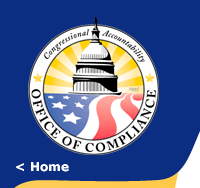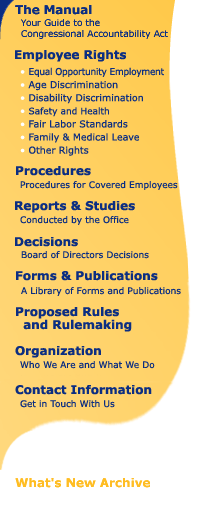 |

|
 |
|||
|
OFFICE OF COMPLIANCE _________________________ GLORIA A. HALCOMB, Before the Board of Directors: Susan
S. Robfogel, Chair; Barbara L. Camens, Alan V. Friedman; Roberta
L. Holzwarth; Barbara Childs Wallace, Members. DECISION AND ORDER OF THE BOARD OF DIRECTORS1 In On February 3, 2004, Hearing Officer, on a motion to dismiss, issued the attached Order dismissing the Complaint against Respondent on jurisdictional grounds; that is, as a matter of law the Respondent could not constitute an employing office under the Congressional Accountability Act, 2 U.S.C. §1301(9): in essence holding that even if the Complainant’s factual allegations were taken as true, jurisdiction would still be lacking over the Respondent. The Complainant timely filed a petition for review of that Order, and a supporting brief. The Respondent timely filed its opposition brief to the petition for review. While we acknowledge that an individual must be employed by one of the nine employers listed in Section 101(3)(A)-(I) [2 U.S.C. §1301(3)(A)-(I))] of the Act in order to be considered a “covered employee”, we do not construe Section 101(3) of the Act as precluding a covered employee from bringing a claim against more than one respondent under a joint-employer or single-employer theory. The ruling in Moore v. Capitol Guide Board, 982 F. Supp. 35 (D.D.C. 1997) does not require us to hold otherwise. Similarly, in light of the general rule of statutory construction that “[i]n determining the meaning of any Act of Congress, unless the context indicates otherwise – words importing the singular include and apply to several persons, parties, or things; words importing the plural include the singular . . .” 1 U.S.C. §1, we do not construe Section 405(a) (2 U.S.C. §1405) as precluding a covered employee from naming more than one employing office as a respondent in a complaint filed with the Office of Compliance under the Act. Accordingly, the issue to be resolved is whether Respondent may be considered an “employing office” under Section 101(9) (2 U.S.C. 1301(9))of the Act. Complainant has alleged that Respondent meets the definition of an employing office contained in Section 101(9)(C), which encompasses as an employing office “any other office headed by a person with the final authority to appoint, hire, discharge, and set the terms, conditions, or privileges of the employment of an employee of the House of Representatives or the Senate”. The record before us is limited to the pleadings, which include the allegation that there is an integrated relationship between the Respondent and the Senate Sergeant at Arms and the Congressional leadership. Based on the limited record, we are unable to determine whether the Respondent is an employing office under Section 101(9)(C) of the Act. The question was not amenable to dismissal without first affording the Complainant the opportunity to develop a factual record. We are remanding this matter to the Hearing Officer to permit the Complainant an opportunity to prove her claim that the Respondent constitutes an employing office as described in Section 101(9)(C) of the Act. We have not reached any conclusion as to whether the Respondent could constitute an employing office under the Act. We hold only that the Hearing Officer should permit limited discovery on the issue. Once this discovery is completed, Respondent may reassert its position through a dispositive motion. ORDER Pursuant to Section 406(e) of the Congressional Accountability Act and Section 8.01(d) of the Office’s Procedural Rules, the Board remands this matter to the Hearing Officer in accord with this opinion. It is so ordered. Issued, Washington, D.C.: June 4, 2004
CERTIFICATE OF SERVICE I hereby certify that on this 4th day of June 2004, I delivered a copy of this Decision and Order of the Board of Directors to the following parties by the below identified means: First-Class Mail Postage-Prepaid Lawrence Z. Lorber & Stephanie L. Marn,
Esqs. Sam E. Taylor, Administrative Counsel
Lawrence Z. Lorber & Stephanie L. Marn, Esqs.
1 The proper name of the “Association” and the “Executive Board” is reflected as corrected by Respondent’s Reply Brief and Opposition
|
|
||